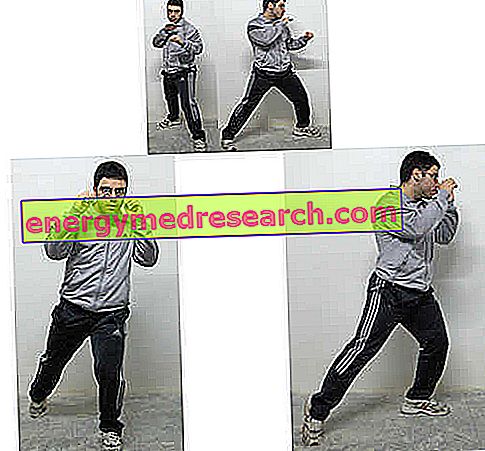«The starting position of the circular football
We have seen how the starting position of circular football should be, but let us now see the dynamics of the blow itself. We have said that the first movement to be carried out is the complete distension of the posterior leg so as to favor the movement of the whole trunk forward with a trajectory that remembers that of the stroke itself. At the same time as this movement, however, it is necessary to carry out another at the level of the anterior lower limb, but above all at the level of the gluteus parallel to the same. This movement consists of a push by the great gluteus, middle gluteus, small buttock, pear-shaped, internal obturator, tensor of the fascia lata and in part of the biceps femoris, semitendinosus, semimebranosus and other agonist muscles of the quadriceps femoris of the hind limb present on anterior limb and on the parallel buttock. This movement guarantees more power per stroke, but it is good to remember, most of this power in the nascent phase of the technique is guaranteed by the thrust of the quadriceps. During the execution of these movements another one must start, whose conclusion, however, must not coincide with that of the other two, but must end simultaneously with the impact phase of the kick with the target (impact that can also be ideal, if you try the vacuum technique or if it is dodged during the fight). It is the internal rotation of the pelvis (the oblique abdominal muscles contract). This is the movement that contributes most significantly to giving the circular trajectory to the shot!
 | |
IMAGE 9 The correct position that the body should take once the distension of the posterior lower limb is finished. | IMAGE 8 As in image 9, side view. Note that with respect to the starting position the trunk and the head are closer to the front lower limb, therefore to the opponent. This sudden approach to the opponent could be a strategic problem. |
However, this movement must be very accurately coordinated with the other movements that synthetically constitute the entire stroke, because if this were not the case, energy losses would occur: when one lower limb is advanced with respect to the other, an excessive internal rotation ( consequence of a movement carried out too early compared to that of distension of the posterior lower limb) helps to detach the heel of the posterior foot from the ground (all this could perhaps be obviated with adequate training of articular mobility at the level of the ankle joint) and to force this foot into precarious support with the ground that:
- destabilizes the balance so that, if the opponent were to put into practice actions aimed at further destabilizing the position, the ability to maintain the standing or similar positions with consequent defeat would be completely lost;
- decreases the force generated by the quadriceps of the back leg (only in a very exasperated rotation) because it does not provide the limb with a sufficiently stable support;
- exposes the ankle to injuries.
 |
IMAGE 10 This photograph shows the (wrong) position that assumes who knocks the pelvis too much and too early. |
If, on the contrary, the rotation movement of the pelvis is started too late (after the distension has ended) a passive phase is created in the execution of the technique (between the end of the distension of the posterior leg and the beginning of the rotation of the pelvis no muscle is contracted isotonically6, therefore no force is generated) in which the body moves by inertia, therefore the power of the blow generated previously continues to decrease until such phase lasts.
It follows that the rotation of the pelvis must begin during the distension movement of the leg and must end at the moment of impact with the target.
Now, when the posterior lower limb detaches from the ground, the only muscles that generate strength are those responsible for the rotation of the pelvis. To amplify their power while the limb that kicks is in the position of suspension7 the upper limbs are thrown in the direction in which the rotation takes place, if the tactical situation does not require protection for the head, neck or trunk. Another shrewdness that amplifies the power generated by the oblique abdominals consists in lifting the support foot off the ground until only the forefoot is supported. In fact, if the foot were to be completely detached from the ground, any resistance offered by friction or other forces would be lacking, so that the stroke would advance more rapidly and retain more of its original power, but the balance in this way would be too precarious! Never forget that all these techniques are martial arts blows! Not gymnastic gestures for their own sake! Therefore we must always lower them into a realistic combat situation. In combat, in fact, it would be easy to lose your balance due to an opposing action and you cannot afford a flight phase every time you roll a circular kick. To facilitate the action of the muscles of the anterior lower limb which are agonists of the quadriceps femoris of the posterior lower limb it is best not to detach the sole of the anterior foot until the action of the aforementioned muscles is not exhausted. In fact, if it comes off first, the agonists of the quadriceps find themselves having to perform their task in a more disadvantageous lever, because lifting the heel would lengthen the arm of the resistance, represented by the entire front lower limb up to the point of support, which instead of being the heel, it is the forefoot (farther from the fulcrum).
After the posterior lower limb has detached from the ground, it is necessary that it flexes again as quickly as possible to assume a more aerodynamic position (and reduce friction). A simultaneous slight intrarotation of the thigh may also be useful so that the leg is positioned with the front part (in reference to the anatomical position8) facing the target.
 | |
IMAGE 12 Important position of passage in the execution of the circular stock seen from the front | IMAGE 11 As in image 12 viewed from the side. Notice how the supporting leg is slightly bent. This helps to maintain balance during the performance of the kick |
In the final phase of the movement, the leg that kicks, previously flexed, must extend so that it reaches the target almost completely stretched. It will not extend completely before reaching the target because if this were done the power generated by the femoral quadriceps will be depleted by the action of the antagonists (leg flexors), as is done during workouts in which you hit with a vacuum (in jargon), "in the shade") or, worse, to discharge against the knee joint (very dangerous for the health of the same, as well as painful); it will not extend too little, because if it were done this way the strength of the quadriceps would apply to the limb for too little time and it would not generate that acceleration that would be had if it were done differently and that would cause a greater power.
Still in the final phase of the execution of the stroke, if the tactical situation does not require particular protections (parades or deviations), it is desirable that the upper limb parallel to the lower limb is slender in a long attitude9 in the opposite direction to that in which it travels calcium so that the shoulder blade closes. This gives the trunk a push in the opposite direction to that of the football that, through the basin, moves, like a wave, to the limb that kicks, giving the blow the characteristics of a whip. With the other upper limb it is always better to protect the face (closed fist, forearm perpendicular to the ground, in flexion on the arm and at about 45 ° with respect to the front).
Another technical parameter to be respected is the contraction of the abdominal muscles at the moment of impact: this is a shrewdness that serves to guarantee to the fighter who performs the circular kick that rigidity of the trunk that if absent, in addition to making the balance unstable, can favor the taking of incorrect positions for the purpose of directing the force. Since the abdominal muscles are expiratory muscles that intervene in forced expiration, in some martial disciplines (Muay Thai, Karate) it is used to emit a scream when the blow crashes against the target, so that there is that contraction of above.
 | |
IMAGE 14 Another passing position in the execution of the football seen from the front. | IMAGE 13 as in image 14 viewed from the side |
At the moment when the blow hits the target, however, above all one thing is very important: the attitude of the foot of the supporting limb. It has been said that while the kicking leg travels towards the target, after the detachment of the same, the heel of the supporting leg must be raised from the ground to ensure greater effectiveness of the technique. However, this is not valid at the most important moment of the performance: the one in which the kick must cause its effect by hitting the opponent. In fact, at the moment when the shot crashes against the target, the action that the kicking limb exerts on the target, for the third principle of dynamics, corresponds to an equal and opposite reaction which, if not opposed to any other force (apart, of course, viscous friction), it cannot be used advantageously as an additional source of power for football. If to this reaction equal and contrary to the action of the kicking limb a third equal and contrary to the second one was opposed, the second would react to this third action, always for the third principle of the dynamics, in an equal and opposite way, that is similar to the first action, that of the kicking leg. In this way the action of the circular kick would increase. But where can the force that opposes the reaction generated by the action of the kicking leg come from? From the sliding friction of the body resting on the sole of the foot of the support leg. If the heel of the supporting leg is resting on the ground at the moment of impact, a considerable friction force is created which prevents the backward movement of the limb that has kicked along its trajectory: when the body is supported on a surface and you want to perform a movement similar to a rotation around your longitudinal axis, the only point of the part of the body on which you are resting that rotates is the point exactly below the center of gravity of the body, all the other points perform a movement of revolution around the point below the center of gravity. Now, the rotational movement that the support point under the center of gravity performs does not generate frictional force (it is like pointing a pencil against a sheet of paper and making it rotate around its axis without moving the mine: as much as it can be pressed strong towards the sheet, the effort that will be made to rotate the pencil will always be the same), but it is the other points, those that translate, that generate this force. If there were no points moving, there would be no friction force, a situation that would ideally be transferable to the circular stock whose final phase is made with the heel and sole of the foot of the supporting leg raised. It follows that, in order to have a greater friction force to rely on, it is good to keep the support foot completely resting on the ground.
 |
IMAGE 15 This photograph depicts the moment of impact of the leg with the target. Notice how the upper limb parallel to the supporting leg remains high to protect the face, while the contralateral one is slender in the opposite direction to that of the football. |
Once the shot has been exhausted against the target (or empty), a bending of the leg is required which struck as quickly as possible to prevent the limb from being grasped by the opponent (which can be verified if he succeeds in some way to avoid being hit or cashing in). If this happened, the fight could be concluded in favor of the adversary (from a hold on a lower limb it can be concluded, for example, with a joint lever that breaks the limb, or with a projection10 that forces a position too unfavorable because you can have the best). One must however be careful not to schedule this movement too early, starting to flex the muscles responsible for performing it when the kick has not yet reached the target (error, this, quite common). Should this happen, it is true that the probability that the opponent is able to grab the limb that is struck is reduced because the time in which it remains in extension decreases, but in this way the movement that executes the limb that kicks is transformed in a harmonic motion, starting a voluntary deceleration of the blow even before it has reached the target. In doing so you lose a lot of power!
Simultaneous with this movement must be the movement of rotation of the pelvis and adduction and external rotation of the thigh to return to the starting position in which the limb that was previously posterior here becomes anterior and vice versa. Then he can lower the leg he has kicked to regain contact with the ground in the guard position.
»Continue ... the training of circular football
THEORY AND TECHNIQUE OF CIRCULAR SOCCER



